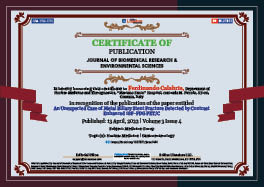Ferdinando Calabria* and Mario Leporace
Volume3-Issue4
Dates: Received: 2022-03-28 | Accepted: 2022-04-08 | Published: 2022-04-13
Pages: 332-334
Abstract
18F-FDG PET/CT is an useful diagnostic tool for cancer patients. In our routine practice, we perform a significant number of PET/CT scans in association with contrast enhanced CT, to assess resectability of abdominal tumors or to evaluate distant brain and liver metastases. We documented an unexpected emergency disease during a contrast enhanced 18F-FDG PET/CT. In a 63-year-old male patient, examined during follow-up of lung cancer, no sites of disease relapse were detected at PET/CT; nevertheless, diffuse tracer uptake was detected along the outline of a biliary stent. Correlative contrast enhanced CT diagnosed fracture of a metallic biliary stent without any evidence of cancer involvement. Patient was referred to the local department of surgery for substitution of the biliary stent. Although rare, unexpected emergency diseases requiring urgent management are detected using 18FFDG PET/CT. Correlative CT should be carefully evaluated in order to avoid delays in diagnosis, potentially leading to poorer prognosis.
FullText HTML
FullText PDF
DOI: 10.37871/jbres1444
Certificate of Publication

Copyright
© 2022 Calabria F, et al. Distributed under Creative Commons CC-BY 4.0
How to cite this article
Calabria F, Leporace M. An Unexpected Case of Metal Biliary Stent Fracture Detected by Contrast Enhanced 18F-FDG PET/C. J Biomed Res Environ Sci. 2022 Apr 13; 3(4): 332-334. doi: 10.37871/jbres1444, Article ID: JBRES1444, Available at: https://www.jelsciences.com/articles/jbres1444.pdf
Subject area(s)
References
- Nakagawa K, Aoyagi M, Inaji M, Maehara T, Toriyama H, Kawano Y, Tamaki M, Nariai T, Ohno K. [The usefulness of whole body FDG-PET/CT in patients with brain metastasis]. No Shinkei Geka. 2009 Feb;37(2):159-66. Japanese. PMID: 19227157.
- Hundt W, la Fougère C, Vogtmann J, Steinbach S, Burbelko M, Tiling R. Evaluation of contrast medium enhancement and [(18)F]-FDG uptake of liver metastasis in PET/CT prior to therapy. Eur J Radiol. 2012 Apr;81(4):652-7. doi: 10.1016/j.ejrad.2011.01.026. Epub 2011 Feb 5. PMID: 21300504.
- Toriihara A, Yamaga E, Nakadate M, Oyama J, Tateishi U. Detection of unexpected emergency diseases using FDG-PET/CT in oncology patients. Jpn J Radiol. 2017 Sep;35(9):539-545. doi: 10.1007/s11604-017-0664-5. Epub 2017 Jul 3. PMID: 28674772.
- Alkhiari R, Patel V, Cohen L. Spontaneous fracture of a covered self-expandable biliary metal stent and endoscopic technique for removal. Can J Gastroenterol Hepatol. 2014;28:411-412.
- Catalano O, De Bellis M, Sandomenico F, de Lutio di Castelguidone E, Delrio P, Petrillo A. Complications of biliary and gastrointestinal stents: MDCT of the cancer patient. AJR Am J Roentgenol. 2012 Aug;199(2):W187-96. doi: 10.2214/AJR.11.7145. PMID: 22826420.
- Sriram PV, Ramakrishnan A, Rao GV, Nageshwar Reddy D. Spontaneous fracture of a biliary self-expanding metal stent. Endoscopy. 2004;36:1035-1036.
- Yoshida H, Mamada Y, Taniai N, Mizuguchi Y, Shimizu T, Aimoto T, Nakamura Y, Nomura T, Yokomuro S, Arima Y, Uchida E, Misawa H, Uchida E, Tajiri T. Fracture of an expandable metallic stent placed for biliary obstruction due to common bile duct carcinoma. J Nippon Med Sch. 2006 Jun;73(3):164-8. doi: 10.1272/jnms.73.164. PMID: 16790985.
- Bruzzi JF, Truong MT, Marom EM, Mawlawi O, Podoloff DA, Macapinlac HA, Munden RF. Incidental findings on integrated PET/CT that do not accumulate 18F-FDG. AJR Am J Roentgenol. 2006 Oct;187(4):1116-23. doi: 10.2214/AJR.05.0712. Erratum in: AJR Am J Roentgenol. 2007 Feb;188(2):300. PMID: 16985164.
- Osman MM, Cohade C, Fishman EK, Wahl RL. Clinically significant incidental findings on the unenhanced CT portion of PET/CT studies: frequency in 250 patients. J Nucl Med. 2005 Aug;46(8):1352-5. PMID: 16085594.






























































